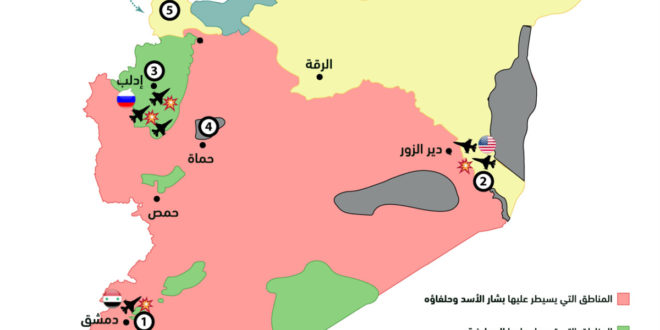Geostrategic Media Center
The US-Russian rivalry in Syria has taken several steps since the war began, and it is entering a new phase, characterized by an unambiguous talk about Syria’s oil wealth, as an important card to chart a new political and military map for the country.
As Russia intervened with its military and political power to ensure that Bashar al-Assad’s regime will not be defeated in the war and thus Moscow will not lose its main military bases in the Middle East, the United States chose qualitative intervention by supporting Kurdish fighters, controlling oil-rich areas and strategic sites that would have a final say in determining Syria’s future.
In the east of the country lies Deir Al-Zour, an oil and gas reservoir, which constitutes 17% of Syria’s territory and the country’s strategic agriculture. The province is a major arena for the US-Russian non-covert competition, which is going on without a direct confrontation between the two forces.
The latest of these chapters is what happened on February 7 night in the eastern countryside of Deir al-Zour between the villages of Khasham and Tabiya, east of the Euphrates River, where there are important oil sites.
The US-led coalition announced that it had launched air strikes on pro-Syrian forces in the area about eight kilometers east of the Euphrates River, the dividing line between the US-backed Kurdish Syria’s Democratic Forces (SDF) and the Syrian Arab Army troops,
A US official, speaking on condition of anonymity, said coalition strikes killed more than 100 fighters loyal to the Syrian regime after the coalition foiled an attack on the headquarters of the (SDF) in Deir al-Zour.
“We suspect that forces loyal to the Syrian regime were trying to control territory liberated by (SDF) from Daesh in September 2017,” the US official said in comments carried by Reuters. He added that these forces “were probably seeking to control the oil fields in Khasham, which was an important source of revenue of Daesh between 2014 and 2017.”
The official said that the attack by forces loyal to the Syrian regime was significant, with about 500 participants, backed by artillery and tanks and rocket launchers and mortars. He added that the coalition had regular contact with Russian officials before the attack was thwarted for a long time, during and after.
For its part, the Russian Defense Ministry said that this incident shows that “the real purpose of the continuation of the US military presence in Syria is not the fight against international terrorism, but the seizure of Syrian economic assets.”
The ministry said that the forces loyal to the Syrian regime near the area of the bombing was carrying out an operation against a dormant cell of Daesh. The Russian Defense Ministry added that the Russian leadership at the Hameimim air base conducted talks with coalition representatives through the open channels after the air strikes, and that the American side confirmed that the oil refinery in that area is under the control of the (SDF) and the American military.
On the other hand, the Syrian News Agency (SANA) reported that the International Coalition bombed “peoples’ forces” allied to the government forces were fighting the (SDF) and Daesh forces east of the Euphrates River.
American presence in the south
With these developments, Russian Foreign Ministry spokeswoman Maria Zakharova said the US military presence in Syria represents a serious challenge to the peaceful settlement of the Syrian crisis and the preservation of the unity of the country.
Zakharova spoke of another arena for US-Russian rivalry in Syria when she said the US-built safe zone in southern Syria was being used by Daesh-organized militants, helping them hide from the Syrian regime and allowing them to regroup and launch new attacks in the Syrian Badia.
In light of the fragile understandings of the relationship between Americans and Russians in Syria, it is difficult to predict the competition mechanisms for oil, border crossings, etc. in Syria, but Moscow is not satisfied with the indirect American control of about 80% of the Syrian oil reserves according to some estimates.
 Geostrategic Media Political Commentary, Analysis, Security, Defense
Geostrategic Media Political Commentary, Analysis, Security, Defense





